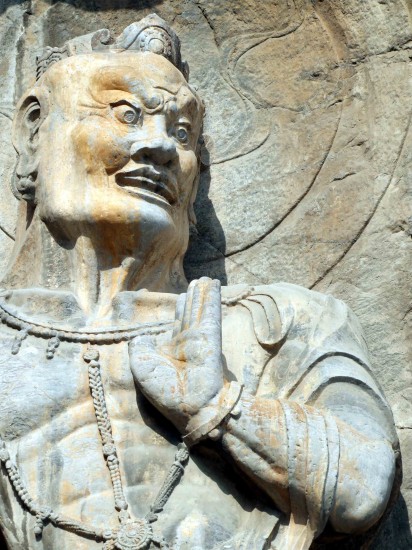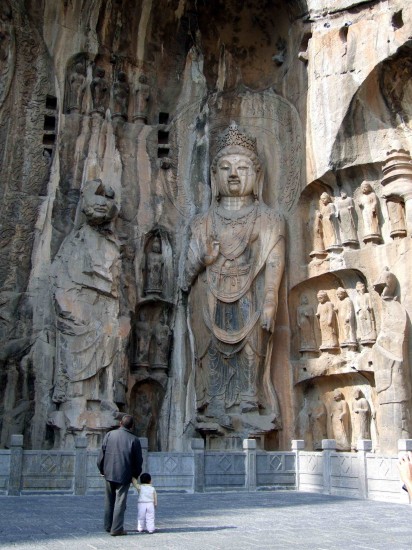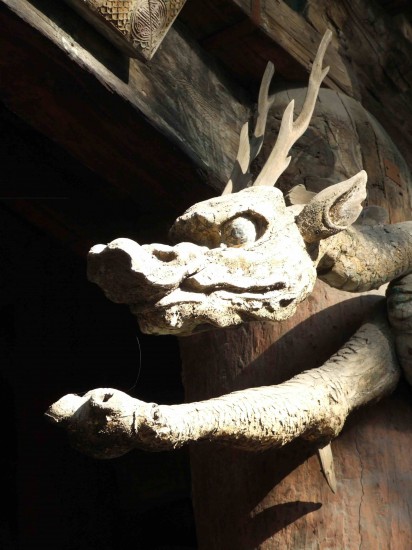Last night we presented Part I of Vincent Ross’ “The Buddhist Treasures of China” featuring temples and shrines which attract millions of Chinese tourists but are not well known to international travellers. Tonight, Vincent takes us to surreal grottoes, unearthly temples and mystical caves. Tomorrow, we’ll feature more of Vincent’s words and photos about the Buddhist treasures of what is still one of the world’s most mysterious countries.
Longmen Grottoes
Carved into cliff faces on both sides of the Yi River, 16km south of Luoyang, the Longmen Grottoes were created over a 200-year period from 494AD, during the Northern Wei Dynasty.
The hand-hewn grottoes stretch for a kilometre and within the honeycomb of 2100 caves are 100,000 images of Buddha ranging in size from 2cm to 17m high. In the 19th and 20th centuries, Western souvenir hunters broke and sawed off heads, and during China’s Cultural Revolution, the Ten Thousand Buddha Cave, carved in 680AD, was badly damaged.
But despite this, the extent of the workmanship is still extraordinary.
Chinese tourists in their millions visit Longmen Grottoes every year and it’s easy to see why. The sheer scope of the Wei craftsmen’s artistic devotion is inspiring.
Jinci Temple
It almost seems as if the builders of Jinci Temple, 25km south-east of Taiyuan in Shanxi Province, had photographers in mind as they worked at constructing a fitting monument to Buddha. It is exquisite.
The temple encompasses a serene balance between architecture, stone, water, wood and the surrounding natural environment. It was built during the Northern Wei Dynasty to honour Shu Yu, the second son of King Wu of the Zhou Dynasty (11th century – 256BC).
Water from the Jin River erupts from the Never Ageing Spring to gush and cascade into a canal through ancient stone gutters encrusted with soft, green moss and goes on to flow beneath the engineering wonder of the stone Feiliang (flying girder) Bridge.
From the ornate, life-size iron guards, cast in 1097AD, which stand at the four corners of the Lotus Platform, to the ancient still-living cypress trees planted during the Zhou Dynasty, epitomized by the gnarled, slumped trunk of the Dragon Tree, which is nearly 3,000 years old, Jinci Temple is the epitome of dignified age and beauty.
Angry reptiles, their carefully crafted bodies wrapped around the temple’s heavy wooden pillars, claws outstretched to catch unwary visitors, are some of the earliest examples of hand-carved wooden temple dragons in China.
Wutai Shan
Wutai Shan (Five Terrace Mountains), a five-hour drive north of Taiyuan, in Shanxi Province, is dominated by 3058m-high Yedou Peak, referred to as the roof of northern China. There is a car park near the peak where tour buses pull over, but the sub-zero conditions and the biting winds which howl over the mountains make taking photographs difficult.
Deep in one of Wutai Shan’s valleys lies the monastic village of Taihuai, with nearly 50 temples and monasteries located in the town and on the surrounding mountainsides.
Even to the unreligious, the monks and pilgrims who spend hours every day prostrating themselves at every few paces up the hundreds of steps which lead to Tayuan Temple and its striking, white bottle-shaped pagoda, are mystically impressive.
From morning prayers to evening bells, Taihuai is steeped in Chinese Buddhist sounds and symbolism… and more than a few tourists.
Yungang Caves
If the Longmen Grottoes are impressive, then these cave excavations are truly awesome. The Yungang Caves, 16km west of Datong, are cut into the cliffs of Wuzhou Shan near the pass to Inner Mongolia.
The caves house more than 50,000 Buddhist statues, recognised as some of the best existing examples of ancient Chinese sculpture.
Yungang was carved out of the limestone during the Northern Wei Dynasty (460AD-494AD) and continued through the Liao and Qing dynasties.
The story of how the caves came to be built could make for the basis of an epic Chinese opera. The Emperor Taiwu, whose statue sits in Cave 18, was a great supporter of Buddhism, but changed to Taoism. Taiwu blamed a regional revolt on the Buddhists and from 446AD – 452AD his soldiers murdered thousands of monks and destroy statues, temples and monasteries.
Unable to prevent his father’s actions, Taiwu’s son is said to have died of a broken heart and posthumously given the title of emperor.
Taiwu’s grandson, Emperor Wencheng, came to power and set about restoring Buddhism – including the excavation of the caves – in compensation for his grandfather’s atrocities against the faith.
Photo Credits
All photos © 2008 Vincent Ross . All rights Reserved.
Longmen Grottoes – Henan Province – China (c) Vincent Ross
Longmen Grottoes – Henan Province – China (c) Vincent Ross
Jinci Temple – Taiyuan – Shanxi Province – China (c) Vincent Ross
Prostrate Buddhist monk – Taihuai – Wutai Shan – Shanxi Province – China (c) Vincent Ross






I’m putting this destination into my bucket list (first time I’ve ever used that expression).
What a history! Makes it interesting to watch China’s religious future unfold.